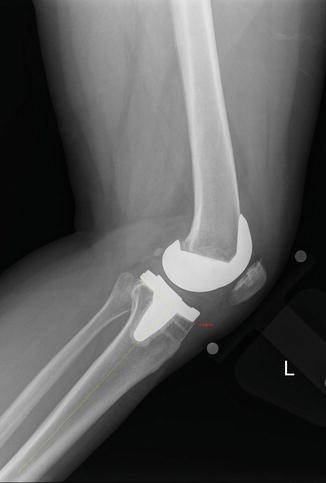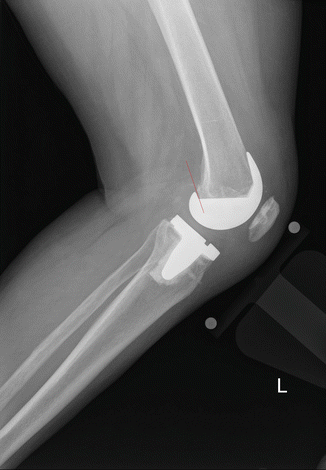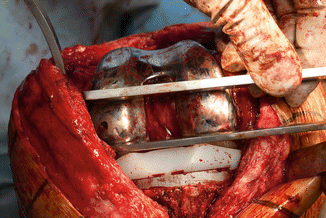Fig. 8.1
Standing long-leg radiograph of a patient with neutral mechanical alignment after a left primary cemented posterior-stabilized TKA
8.2.2 Sagittal Alignment
Tibial slope is generated by the proximal tibial osteotomy and the polyethylene component, but targets vary from 0 to 7° (Fig. 8.2). While poorly studied, tibial slope requires a balance between achieving adequate flexion [28, 29] and the risk of instability [30]. However, similar short-term range of motion (ROM) and outcomes are seen with 0° and 5° targets [31]. Singh et al. [32] showed that tibial slope did not predict short-term ROM, but drastic changes from preoperative alignment significantly restricted ROM and function in 209 posterior-stabilized (PS) TKAs. All alignment measures were interrelated, and small rotational errors drastically altered the mechanical alignment at 7° and 10° of tibial slope [33]. Lastly, extremes of tibial slope (<0° or > 7°) have been shown to increase revision rates at 15.8 years [26].


Fig. 8.2
Lateral radiograph depicting 3° of targeted posterior tibial slope in this posterior-stabilized TKA
Femoral components positioned in flexion are also associated with complications including painful patellar crepitus [34], and a threefold increased risk of flexion contractures in those with components flexed >3.5° (Fig. 8.3) [35]. Murphy et al. [36] randomized patients to two femoral flexion angles (4° and 0°) and found that higher angles allowed greater ROM, but outcomes were similar (including patient satisfaction) [36]. However, Kim et al. [26] reported more revisions for flexed components (>3°) compared to those that were extended (<0°) or neutrally aligned (0–3°).


Fig. 8.3
Lateral radiograph showing neutral sagittal alignment of the femoral component as judged by the posterior condylar line being parallel to the posterior cortex of the femur
8.2.3 Rotational Alignment
Whiteside’s line, the surgical transepicondylar axis (TEA), the anatomical transepicondylar axis, and the posterior condylar axis as well as gap-balancing techniques can be used to align the femoral component (Fig. 8.4). The surgical TEA is the most widely used despite high intra- and interobserver variability [37], which may explain why 50 % of TKAs do not achieve rotational alignment (0 ± 3°) [30, 38]. Poor patellar mechanics and high contact stresses are seen with excessive internal femoral rotation [39–41]. Additionally, internal rotation (>3° from the surgical TEA) is associated with postoperative pain [42, 43] and dissatisfaction [44]. Kim et al. [26] showed extreme external rotation produced more failures.


Fig. 8.4
Intraoperative picture at the time of revision TKA depicting adequate femoral rotation with the posterior condylar axis (inferior osteotome) being parallel to the surgical transepicondylar axis (superior osteotome)
To assist with rotation, surgeons have used anatomic fit, tibial tubercle referencing, or matching the femoral component to an aligned tibia. Internal rotation of the tibia (>9°) has shown more pain and functional deficits [42, 45] and is a common reason for revision in the setting of excessive postoperative stiffness [46]. Kim et al. [26] showed worse survivorship for the extremes of external rotation of the femoral and tibial components. Lastly, rotational mismatch (>5.6°) between femoral and tibial components has shown greater postoperative pain [42]. However, femoral rotation may have a greater effect on overall biomechanics [47].
8.2.4 Kinematic Alignment
Although neutral alignment remains the gold standard, patient dissatisfaction has sparked interest in a more natural TKA. Bellemans et al. [48] studied 250 asymptomatic young adults and noted that 32 % of men and 17 % of women have varus mechanical alignment (>3°). In addition, a single flexion angle may more accurately describe kinematics about the knee [49]. Howell et al. [7, 50, 51] utilized preoperative MRIs to create a patient-specific model. Component positioning attempted to approximate the pre-arthritic joint surface. An early cohort achieved acceptable Knee Society Scores (KSS) at 6 months with 95 % reporting their knee as “nearly normal” or “normal” [52]. A longer-term (3 years) follow-up study of 214 kinematically aligned TKAs showed 65 % of tibial components and 33 % of knees were aligned in varus (>3° from neutral), but no catastrophic failures were reported [7]. Additionally, conventional instruments have achieved high mechanical axis alignment for kinematically aligned TKAs, although tibial and overall alignments remain more variable [51]. Dossett et al. [53] randomized 44 patients to kinematically aligned, patient-specific TKAs and 44 to mechanically aligned, conventional TKAs. Kinematic alignment produced more valgus femoral and varus tibial components, but KSS and WOMAC scores were significantly better at 2 years. Although short-term results were promising, Abdel et al. [27, 54] noted that survivorship may not persist in the long term and follow-up studies are required.
An in-depth discussion of alignment targets and kinematic TKA follows in Chap. 13.
8.3 Soft-Tissue Balancing
Balancing exemplifies the art of surgery, as most surgeons use subjective feel to achieve adequate stability and ROM. Adding to this complexity, soft tissues have varied effects in flexion and extension [41, 55], and anatomic landmarks are inconsistent in deformed, arthritic knees [56]. Traditional approaches are measured resection, gap balancing, and a hybrid method [57]. Recently, tensor devices have been introduced to enhance gap-balancing techniques [8, 58, 59]. The tibial cut, and thus femoral rotation, is vital in achieving a balanced knee with the gap-balancing technique. As mentioned, rotational component alignment significantly affects outcome [26, 42–44, 60].
8.3.1 Gap Balancing Versus Measured Resection
Gap balancing typically occurs with extension balancing first to achieve stability [61]. As such, the tibial resection is paramount to balancing the knee as a varus resection causes excessive femoral component internal rotation, while the opposite is true for a valgus osteotomy [61]. Measured resection allows the osteotomies of the tibia and femur to occur prior to significant soft-tissue balancing. Instead of using tension, anatomic landmarks (e.g., surgical TEA, Whiteside’s line, posterior condylar axis) are used to judge femoral rotation. However, these landmarks may occasionally be difficult to assess [62–64], and rotational alignment is variable, especially when referencing from the surgical TEA [37, 65, 66]. Use of multiple landmarks may help reduce rotational malalignment [67]. Some claim gap balancing produces better rectangular balance in flexion and extension without sacrificing femoral rotational accuracy [61, 68]. Others claim no difference [59, 69]. Compared to the measured resection technique, gap balancing has less condylar lift off throughout ROM [67], restores the joint line more accurately [70], and produces less flexion contractures [71]. However, no differences in KSS [23, 24, 72] or functional quality of life [73] have been reported at 2 years. In addition, some have reported that gap balancing with tensor systems achieves adequate rectangular gaps in flexion and extension more frequently than measured resection [58]. Longer-term outcomes and survivorship have not been reported.
8.4 Minimally Invasive TKA
Introduced over a decade ago by Bonutti et al. [74], a variety of techniques have been described for minimally invasive surgical (MIS) TKAs. These include the quadriceps sparing, mini-subvastus, mini-medial parapatellar, and minimally invasive lateral approaches. The goal is to reduce soft-tissue trauma. Benefits include smaller skin incisions (<14 cm), less disruption to the vastus medialis insertion, and avoidance of patella eversion and tibial-femoral dislocation [75]. However, learning curves are substantial [76, 77], and a volume of greater than 25 cases is required to reduce operative times [76] and component malalignment [78].
8.4.1 Outcome for MIS TKA
Midterm outcomes are similar between conventional and MIS TKAs. However, MIS has supported faster gains in the early recovery [79–83]. Skin incision length is approximately 4 cm shorter than conventional exposures [79, 80]. Radiographic malalignment in the coronal plane has been reported to be similar between the two techniques [79, 81, 83], but some conflicting reports exist [82]. In a randomized clinical trial (RCT) comparing three groups, computer-assisted surgery (CAS) quadriceps sparing (QS) MIS TKA, QS MIS TKA without navigation, and conventional TKA, Lin et al. [84] showed coronal alignment was similar among the groups. Others have supported CAS to improve alignment for MIS TKA [85]. In a meta-analysis, ROM was greater in the early postoperative period (6 days–3 months), but final ROM (>1 year postoperatively) has not been reported [79, 80, 82, 83]. Functional scores are similar between the two groups, while short-term KSS was higher for MIS groups [80, 83], and KSS was similar at 1 year [80, 83]. In a non-randomized study comparing 40 CAS MIS TKAs to 40 CAS TKAs, KSS were significantly better for MIS TKA in the short term, but KSS were similar at 5 years. Bonutti et al. [86] reported on their original 103 MIS TKA cohort showing survivorship of 97.1 % at a mean follow-up of 9 years. Neither long-term survivorship nor outcomes have been compared in a randomized controlled fashion.
8.5 Prosthesis Design and Fixation
Prosthesis design is a pivotal aspect of TKA longevity, with some designs showing markedly improved survivorship. The posterior cruciate ligament (PCL) continues to be debated by many. In addition, mobile-bearing (MB) vs. fixed-bearing (FB) designs, metal-backed vs. all-polyethylene tibial components, and uncemented vs. cemented prostheses continue to be debated.
8.5.1 Cruciate Retaining Versus Posterior Stabilized
Cruciate-retaining (CR) prosthetic designs are thought to maintain ROM by restoring normal knee kinematics and anatomic femoral rollback, while posterior-stabilized designs (PS) are thought to control ROM by allowing for an enhanced femoral-tibial articulation [87]. Short-term benefits of each design remain debated. However, many studies have shown increased survivorship with CR designs [88–90]. In a recent meta-analysis restricted to RCTs, Li et al. [91] showed higher ROM for PS TKAs, while KSS and survivorship were similar at 2 and 5 years postoperatively. However, Abdel et al. [88] showed superior survivorship for 5,389 CR TKAs at 15 years. Subanalysis for knees with a preoperative deformity (i.e., flexion and angular deformities >15°) revealed that 15-year survivorship was 90 % for CR TKAs but only 75 % for PS TKAs (p < 0.001). For knees without deformity, survivorship was 88 % for CR TKAs and 78 % for PS TKAs (p < 0.04). Of the 16,584 primary TKAs completed at the same institution between 1985 and 2005, CR designs had significantly better survivorship at 10 and 15 years when stratified by implant manufacturer and design [89].
8.5.2 Mobile-Bearing Designs
Mobile-bearing (MB) TKAs were designed with the intention of reducing wear and thus revision procedures, as well as providing more natural kinematics [92]. In the largest meta-analysis to date, Moskal et al. [93] showed that the rates of aseptic loosening, periprosthetic joint infection, and revision for any cause were similar between MB and FB TKAs. Additionally, ROM, KSS, Hospital for Special Surgery (HSS) scores, and SF-12 scores were similar between the groups. Interestingly, a large series from the International Consortium of Orthopaedic Registries (ICOR) containing 258,190 FB CR TKAs and 61,426 MB CR TKAs showed worse survivorship for MB CR TKAs at yearly time points from years one to ten postoperatively [94]. Additionally, Li et al. [95] showed no difference in patient preference by meta-analysis.
8.5.3 All-Polyethylene Tibia Component
All-polyethylene tibial components provide the benefit of not creating any backside wear and thus have a potential for increased survivorship. In a large meta-analysis and systematic review, survivorship was similar between all-polyethylene and metal-backed tibial components at 2 [96], 10 [96], and 15 years [89, 96]. On the other hand, the Swedish registry data of over 27,000 TKAs supported a higher survival rate and lower revision rate at 10 years for all-polyethylene tibial components [97]. Kremers et al. [89] showed that CR all-polyethylene tibial components had a survivorship superior to CR metal-backed tibial components. However, metal-backed tibial components were superior to the PS design. Of note, an early PS all-polyethylene tibial design (DePuy PFC; Warsaw, IN) showed high failure rates, which inherently skewed the results [89]. Additionally, all-polyethylene tibial components represent a significant cost savings; for community practices, negotiated rates were $3,035 and $2,078, respectively [98]. While all-polyethylene tibial design offers lower costs, greater polyethylene thickness for comparable bone loss, and less backside polyethylene wear, modularity allows intraoperative flexibility and the option of polyethylene exchange in the revision setting [99, 100].
8.5.4 Cementless TKA
Cement fixation remains the gold standard for TKA but may not improve survivorship. Early cementless designs certainly showed inferior survivorship [101]. However, innovations such as hydroxyapatite-coated technology were not used in early comparisons. More recent meta-analyses support similar rates of revision TKAs between cemented and uncemented components [102, 103]. In a meta-analysis of 3,568 TKAs, Mont et al. [103] showed similar survivorship of 95.6 % and 95.3 % at 10 years and 76 and 71 % at 20 years for cementless and cemented TKAs, respectively. Additionally, screw reinforcement did not extend survivorship of cementless TKA [103]. In a systematic review of 5 randomized controlled trials (RCTs) and 297 TKAs, Nakama et al. [102] showed aseptic loosening was twice as likely for cemented TKA at 2 years. Additionally, Voigt and Moiser [104] showed hydroxyapatite-coated tibial components had less migration by radiostereographic analysis compared to both porous-coated and cemented tibial components. Revision rates were similar at 2, 8, and 10 years [104]. For 80 bilateral TKAs (160 knees) in patients younger than 55, Kim et al. [105] randomized one knee to trabecular metal cementless TKA and one to a cemented construct. At 17 years of follow-up, survivorship for aseptic loosening or revision for any cause was similar, and there was no difference in KSS, UCLA activity scores, or ROM. Finally, in an RCT of 397 knees, Pulido et al. [106] showed that both cemented and uncemented highly porous metal tibias provided comparably durable fixation and reliable pain relief and restoration of function when compared with a traditional cemented modular tibia in TKA.
8.6 Host Factors
Patient demographics and comorbidities undoubtedly impact both outcome and survivorship. In a large multivariate study of 117,903 US Medicare patients, Bozic et al. [10] found that chronic pulmonary disease, depression, alcohol abuse, drug abuse, renal disease, hemiplegia/paraplegia, and obesity were associated with early-revision arthroplasty (12 months). Similar systemic comorbidities, such as osteoporosis, corticosteroid use, and rheumatism, have been associated with periprosthetic fractures [107]. However, recent multivariate analyses show younger age as the only significant predictor [108]. Lizaur-Utrilla et al. [109] revealed that the Charlson Comorbidity Index was an independent predictor of failure at a mean of 6 years postoperatively. Failure was defined as KSS <70 or revision arthroplasty, with preoperative functional score being another significant predictor. A study completed by McCalden et al. [110] examined survivorship in patient groups of different ages (<55, 55–70, and >70 years). Knee Society scores and WOMAC pain scores were improved for younger patients, but survivorship was decreased at 5 and 10 years.
Patient factors predict arthrofibrosis as well. Only 74 % of patients with a preoperative ROM <90° achieve a postoperative ROM of >90° [111]. Obesity [112] and a history of prior knee surgery [113] both predict lower postoperative ROM, while subjective stiffness is a common complaint in younger populations [114].
Infection is the most common cause of early revision [115]. A variety of conditions are associated with deep periprosthetic joint infection including obesity [10], diabetes [10], rheumatoid arthritis [116], long-term systemic corticosteroids [116], anticoagulation use [117], smoking [118], and urinary tract infections [119]. For patients that smoke, the number of pack years shows an incremental risk of postoperative complications [120]. Adeli and Parvizi [121] warn that patients should be optimized prior to arthroplasty. Decolonization of potential sources, smoking cessation, immunosuppression adjustments, achieving glycemic control, modifying anticoagulation, and addressing nutritional status should all occur in the preoperative period.
8.7 Conclusion
A variety of factors contribute to a well-functioning, long-lasting TKA. Survivorship with contemporary designs now approaches 90 % at 20 years postoperatively. However, satisfaction remains a concern, and patients are demanding higher function from their TKA. In response, new techniques including kinematic alignment, minimally invasive TKAs, mobile-bearing TKAs, and soft-tissue strategies have been attempted. Despite the promise, long-term survivorship and greater patient satisfaction have yet to be determined with these innovations. Surgical technique, patient selection, and management of patient expectations remain essential to achieving an optimal outcome.
References
1.
Patil S, McCauley JC, Pulido P, Colwell CW Jr (2015) How do knee implants perform past the second decade? Nineteen- to 25-year follow-up of the press-fit condylar design TKA. Clin Orthop Relat Res 473:135–140PubMed
2.
Kurtz S, Ong K, Lau E, Mowat F, Halpern M (2007) Projections of primary and revision hip and knee arthroplasty in the United States from 2005 to 2030. J Bone Joint Surg Am 89:780–785PubMed
3.
W-Dahl A, Robertsson O, Lidgren L (2010) Surgery for knee osteoarthritis in younger patients. Acta Orthop 81:161–164PubMedCentralPubMed
4.
Kurtz SM, Lau E, Ong K, Zhao K, Kelly M, Bozic KJ (2009) Future young patient demand for primary and revision joint replacement: national projections from 2010 to 2030. Clin Orthop Relat Res 467:2606–2612PubMedCentralPubMed
5.
Petersen KK, Simonsen O, Laursen MB, Nielsen TA, Rasmussen S, Arendt-Nielsen L (2015) Chronic postoperative pain after primary and revision total knee arthroplasty. Clin J Pain 31:1–6PubMed
6.
Bauwens K, Matthes G, Wich M et al (2007) Navigated total knee replacement. A meta-analysis. J Bone Joint Surg Am 89:261–269PubMed
7.
Howell SM, Howell SJ, Kuznik KT, Cohen J, Hull ML (2013) Does a kinematically aligned total knee arthroplasty restore function without failure regardless of alignment category? Clin Orthop Relat Res 471:1000–1007PubMedCentralPubMed
8.
Matsumoto T, Muratsu H, Tsumura N et al (2006) Joint gap kinematics in posterior-stabilized total knee arthroplasty measured by a new tensor with the navigation system. J Biomech Eng 128:867–871PubMed
9.
Wegrzyn J, Parratte S, Coleman-Wood K, Kaufman KR, Pagnano MW (2013) The John Insall award: no benefit of minimally invasive TKA on gait and strength outcomes: a randomized controlled trial. Clin Orthop Relat Res 471:46–55PubMedCentralPubMed
Stay updated, free articles. Join our Telegram channel

Full access? Get Clinical Tree








